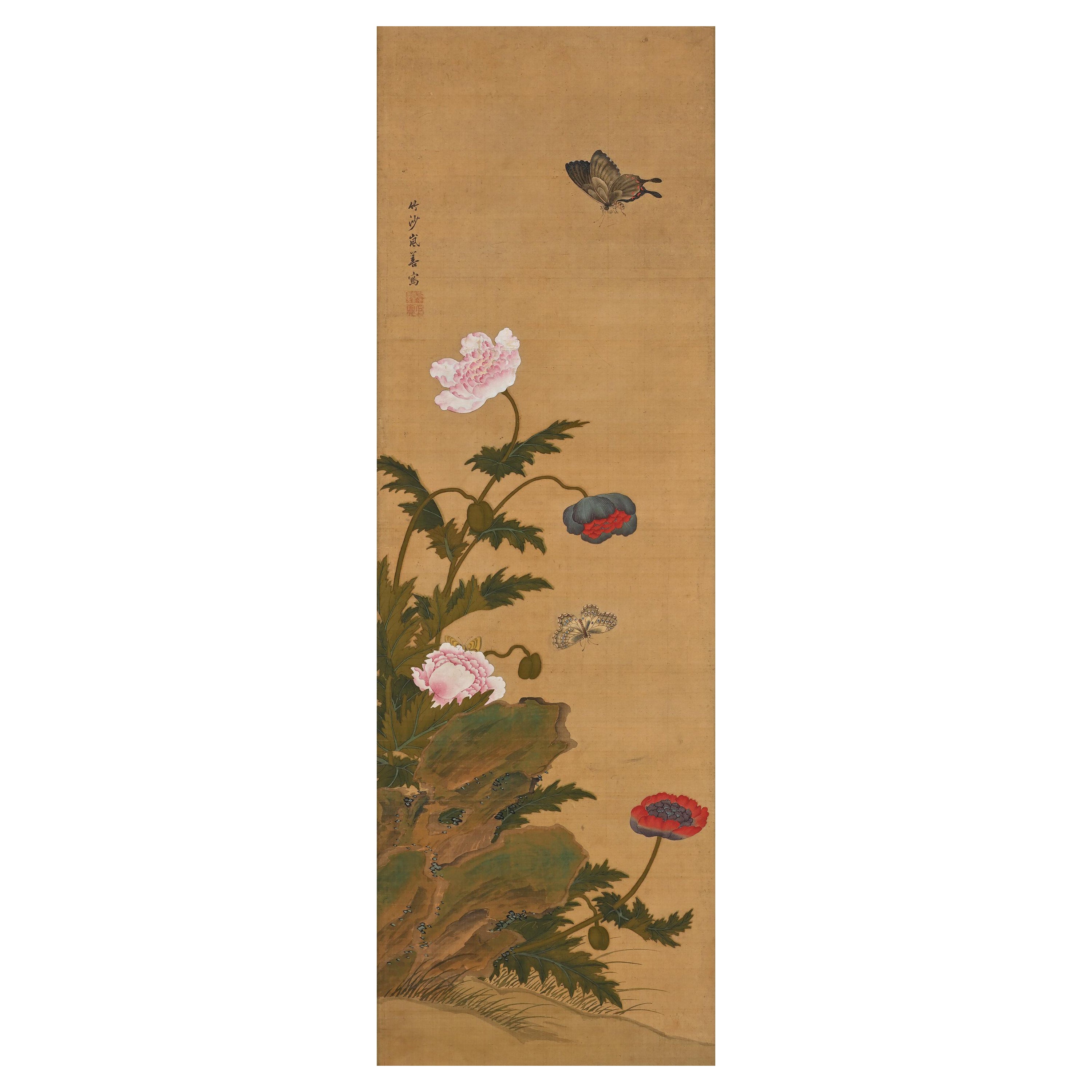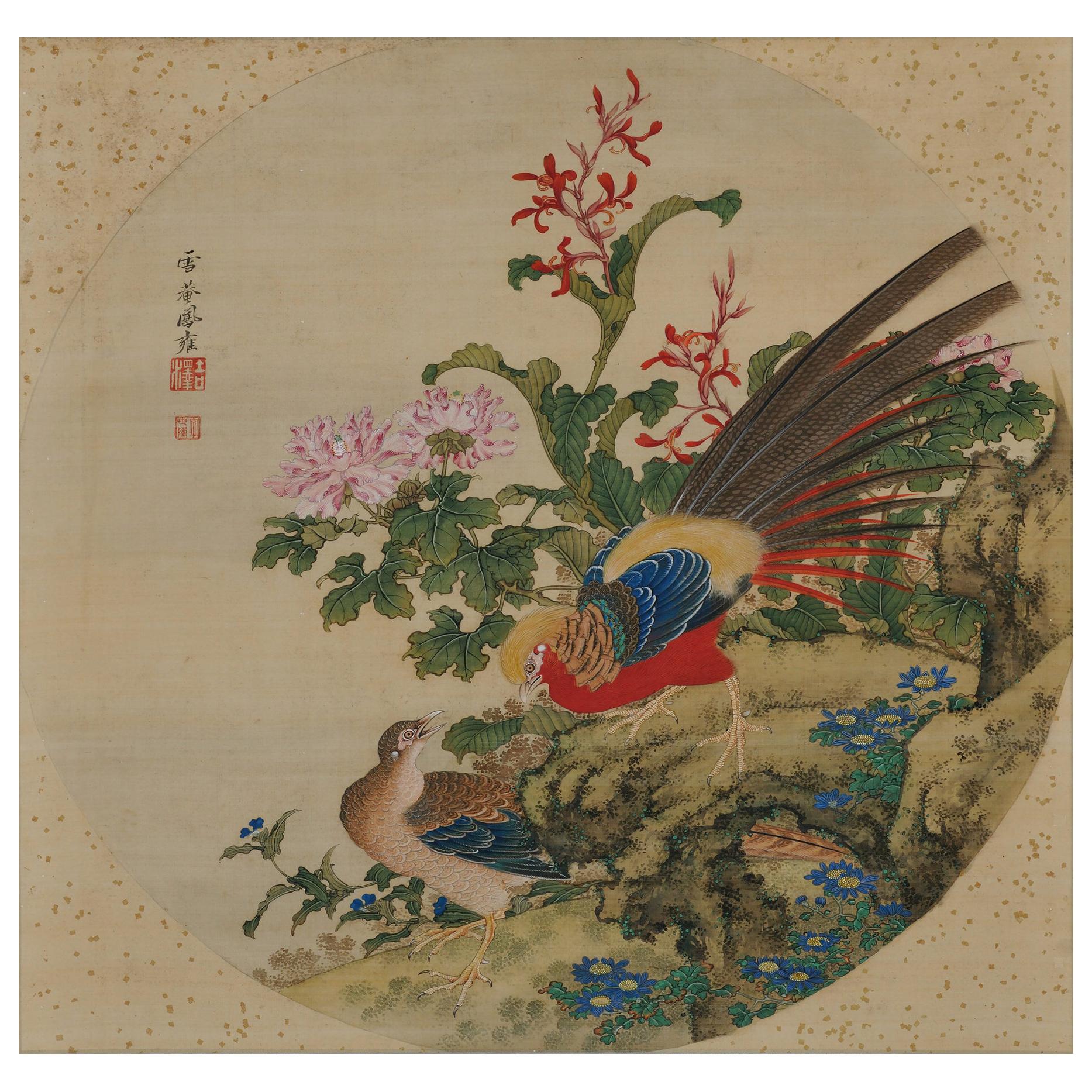Items Similar to Japanese Painting, Hanging Scroll, Mid 19th Century, Koi and Water Plants
Want more images or videos?
Request additional images or videos from the seller
1 of 5
Japanese Painting, Hanging Scroll, Mid 19th Century, Koi and Water Plants
About the Item
Iwase Hirotaka (1808-1877)
Koi and Water Plants
Hanging scroll, ink, color, gold wash and gold flecks on silk
Inscription: Hirotaka
Seal: Illegible
Dimensions:
Scroll: 144 cm x 54.5 cm (56.5" x 21.5")
Image: 59 cm x 43.5 cm (23" x 17")
This vivid depiction of two koi or carp among water plants dates to the mid-19th century. The artist, Iwase Hirotaka, has distorted and exaggerated the facial characteristics of the fish in a method that resembles the art of caricature, adding a humorous and charming touch to a familiar subject. Painted on silk with ink, colors and gold-wash, the scene is enhanced with layered flecks of gold, which act to obscure our view and increase the intimacy of the scene. Unlike the koi paintings of the Maruyama-Shijo school of art, which are painted with a dedication to naturalism, and the somewhat repetitive koi imagery of the long-standing Kano school, the artist here appears to have taken inspiration from the work of Ito Jakuchu, who himself was known to reference Korean paintings for models.
Iwase Hirotaka (1808-1877) was originally a Kyoto based Ukiyo-e artist known as Hishikawa Kiyoharu. At the age of 26 or 27 he moved to Wakayama, changed his name, and began studying Yamato-e with Tanaka Totsugen and Ukita Ikkei. Totsugen and Ikkei were leaders of the Fukko Yamato-e school, and closely connected to a political movement which sought to Revive the power of the Emperor. A diverse and accomplished artist, Iwase Hirotaka eventually turned to literati painting, which he learned from Tetsuo Somon.
- Creator:Iwase Hirotaka (Artist)
- Dimensions:Height: 56.5 in (143.51 cm)Width: 21.5 in (54.61 cm)Depth: 0.75 in (1.91 cm)
- Style:Edo (Of the Period)
- Materials and Techniques:
- Place of Origin:
- Period:
- Date of Manufacture:circa 1860
- Condition:Refinished. Wear consistent with age and use. Conservation and full re-mounting undertaken in Kyoto utilizing traditional techniques and craftsmen.
- Seller Location:Kyoto, JP
- Reference Number:1stDibs: LU2472313833961
About the Seller
5.0
Recognized Seller
These prestigious sellers are industry leaders and represent the highest echelon for item quality and design.
Gold Seller
These expertly vetted sellers are highly rated and consistently exceed customer expectations.
Established in 2001
1stDibs seller since 2016
60 sales on 1stDibs
Typical response time: 6 hours
- ShippingRetrieving quote...Ships From: Kyoto, Japan
- Return PolicyA return for this item may be initiated within 10 days of delivery.
More From This SellerView All
- Japanese Painting, Hanging Scroll, 19th Century Bamboo in MoonlightLocated in Kyoto, JPBamboo in moonlight Gamo Rakan (1784-1866) Hanging scroll, ink on silk. Dimensions: Scroll: 201 cm x 58 cm Image: 137 cm x 45 cm In this early 19th century work by Gamo Rakan a light ink wash applied to the silk background silhouettes the moon and suggests the atmosphere of early evening. Even though it is a literati subject, Rakan’s bamboo is quite realistic with a strong decorative style. The painting finds its inspiration from Chinese Ming dynasty painters who often used a single-tone, jet black stroke to emphasize the calligraphic nature of bamboo. In a different era, decorative would have been seen as somewhat unrefined. But increasingly in the Edo period, it was the hallmark of high style. The Japanese people, in particular the rising merchant class, had gradually become apathetic toward the traditional Sesshu and Kano schools of painting. Chinese professional and amateur painters living in the port of Nagasaki during the 18th century had a profound effect on Japanese painting and the freshness of their style and its decorative appeal contributed greatly to its popularity. Gamo Rakan’s teacher, Tani Buncho...Category
Antique Early 19th Century Japanese Edo Paintings and Screens
MaterialsSilk
- 19th Century Japanese Scroll Painting by Igarashi Chikusa, Poppies & ButterfliesLocated in Kyoto, JPPoppies & Butterflies Ink, pigment and gofun on silk Igarashi Chikusa (1774-1844) Signature: Chikusa Ran Zen Upper Seal: Ran Shuzen Lower Seal: Kyoho Dimensions: Scroll: H. 68” x W. 18” (172cm x 45cm) Image: H. 38.5’’ x W. 12.5’’ (98cm x 32cm) This composition shows elegant images of poppies and the butterflies that are inevitably drawn to them. It captures a momentary glimpse into a world both visually dazzling and startlingly realistic. The painting is infused with sensitivity and attention to seasonal change and weather conditions. The thin and fragile poppies are beautifully depicted with brilliant colors and the butterflies are similarly infused with life. The painting is on silk which requires extremely precise painting skills as no element once painted can be removed. Poppies were a favorite subject of Rinpa school artists through the ages. Originally they were somewhat abstracted but by the age of Sakai Hoitsu...Category
Antique Early 19th Century Japanese Edo Paintings and Screens
MaterialsSilk
- 19th Century Japanese Scroll Painting, Birds & Flowers of the Four SeasonsLocated in Kyoto, JPBirds and flowers of the four seasons Early to mid-19th century Ink, pigment and gofun on silk Unidentified artist Signature: S...Category
Antique 1830s Japanese Edo Paintings and Screens
MaterialsSilk
- Japanese Scroll Painting, 19th Century Chinese Pheasants by Yoshizawa SetsuanLocated in Kyoto, JPChinese Pheasants Yoshizawa Setsuan (1809-1889) Hanging scroll, ink and color on silk. Painting inscription: Setsuan Houyou Upper seal: Y...Category
Antique Mid-19th Century Asian Meiji Paintings and Screens
MaterialsSilk
- 19th Century Japanese Shunga Hand-Scroll, Katsukawa SchoolLocated in Kyoto, JPShunga Unknown artist Meiji era, circa 1880 Hand-scroll mounted with 12 paintings Ink, pigment and gofun on silk Dimensions: Each image measures H. 23.2 cm x W. 34.4 cm (9.15” x 13.5”) The hand-scroll measures H. 28 cm x W. 540 cm (11” x 212”) A set of 12 late 19th century Japanese Shunga paintings mounted as a hand-scroll. Two of the leaves bear the signature and seal ‘Setsuzan’, although we are unable to confirm the identity of the artist using this art name. 6 of the 12 images are taken almost directly from Katsukawa Shuncho’s late 18th century woodblock series, ‘Erotic Pictures...Category
Antique Late 19th Century Japanese Meiji Paintings and Screens
MaterialsSilk
- Japanese Painting, Hanging Scroll, Circa 1930, Amaranth and RoosterLocated in Kyoto, JPAmaranth and Rooster Artist unknown Hanging scroll, ink, mineral pigment and gofun on silk. Painting inscription: Tojo ?? Painting seal: Tojo ?? circa 1930 Dimensions: Scroll:...Category
Early 20th Century Japanese Taisho Paintings and Screens
MaterialsSilk
You May Also Like
- Two Antique Japanese Hanging Scroll PaintingsLocated in Atlanta, GATwo Japanese scroll painting depicts scenes from the Tale of Genji (Genji-E), from Edo period. These painting were purchased from Odewara Shoten in the...Category
Antique Early 19th Century Japanese Japonisme Paintings and Screens
MaterialsBrocade, Paper
- Japanese Antique Ink Painting / 19th Century / Rare Chinese Character PaintingLocated in Sammu-shi, ChibaWe have a unique Japanese aesthetic sense. And only we can introduce unique items through our purchasing channels in Japan and the experience we have gained so far, in such a way that no one else can imitate. It is an ink painting written after the Meiji era. The biggest attraction of this work is that it uses Chinese characters to create paintings. To explain in detail, it is written here in Chinese characters as "un-ryu" . "Un" is a cloud and "ryu" is a dragon. These are embodied and drawn by comparing them to the meaning of Chinese characters. And the clouds depict the clouds hanging over the mountain, and the dragon depicts the climbing toward the mountain. Humorous paintings...Category
Antique Late 19th Century Japanese Edo Paintings
MaterialsAcrylic, Paper
- 18th Century Japanese Scroll of PoppiesLocated in Hudson, NY18th century Japanese scroll of poppies. Edo Period (early 18th century) Japanese painting of poppies with lilies in the background. Seal on the lower...Category
Antique Early 18th Century Japanese Edo Paintings and Screens
MaterialsSilk, Paper
- Antique hanging scroll of Japanese cat/Late Edo-Meiji period/Cat paintingLocated in Sammu-shi, ChibaThis is a picture of a cat drawn by a person named "Toshizumi Nitta" from the end of the Edo period to the beginning of the Meiji period. She is a very simple and cute cat. He is a vassal of the Tokugawa Shogunate, born in Ota City, Gunma Prefecture (southern part of Gunma Prefecture). He was related to the Tokugawa family and lived in a large mansion in the Ota clan in Gunma prefecture. However, the Nitta family's territory was very small, and they were by no means a wealthy vassal. He seems to have lived quite poorly. So he painted cats and sold them to people. The Nitta family continued to draw pictures of this cat for four generations. "Nitta toshizumi" is equivalent to the fourth generation. During the Edo period, sericulture was thriving in the Kanto region. Cats were said to be the gods of silkworms, as they drive away mice, the natural enemies of silkworms. It was the Nitta family who drew such a cat on paper, pasted it in the silkworm chamber, and sold it as a mouse repellent. There were also other monks who painted pictures of cats, but the Nitta family in particular was related to the Tokugawa family, so people believed that paintings of cats had special powers. , a lot of paintings...Category
Antique Late 19th Century Japanese Edo Paintings
MaterialsPaper
- Large Framed Japanese Buddhist Amida Temple Hall Painting, Mid-19th CenturyLocated in Austin, TXA large and incredible Japanese painting of a Buddhist temple hall with Amida Nyorai, late Edo or early Meiji period, mid-19th century, Japan. Mounted wit...Category
Antique Mid-19th Century Japanese Meiji Paintings and Screens
MaterialsWood, Paint, Brocade, Silk, Acrylic
- Hanging Scroll by Kamisaka Sekka, JapanLocated in Milano, ITThis painting represents a man waiting under a dark tree. The composition is extremely simple but suggestive. The artist, with few elements, can, in fact, create a vivid and dynamic scene, based on the tension between the strong ink stain that renders the tree and the elegant figure of the man, dressed in an aristocratic robe. Painter and designer, Kamisaka Sekka...Category
Early 20th Century Japanese Paintings and Screens
MaterialsPaper
Recently Viewed
View AllMore Ways To Browse
19th Century Scroll
Painted On Silk
Japanese Mid Century Art
Plants 19th Century
Mid Century Plants
19th Century Painted Scroll
Midcentury Japanese Art
Gold Plant
Antique Japanese Painting
Antique Japanese Paintings
Water Plants
Asia Gold Painting
Asian Painting Gold Art
Japanese Painting 19th
Silk Scroll
19th Century Japanese Paintings
Watered Silk
Hanging Scrolls





